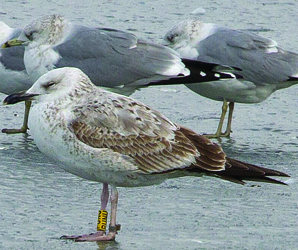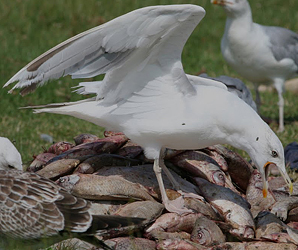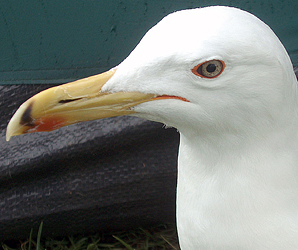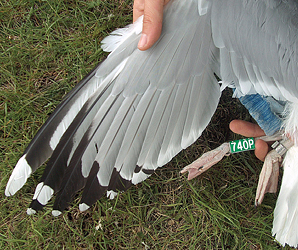 Larus cachinnans
Larus cachinnans
(last update:
Greg Neubauer
Marcin Przymencki
Albert de Jong
Mars Muusse
sub-adult cachinnans: January

In 2011, Chris Gibbins, Grzegorz Neubauer and Brian Small published two extensive papers in Britsih Birds, dealing with Caspian Gull. Below, you will find the content of the second paper "Part 2: phenotypic variability and the field characteristics of hybrids".
The full title reads: From the Rarities Committee's files - Identification of Caspian Gull. Part 2: phenotypic variability and the field characteristics of hybrids, by Chris Gibbins, Grzegorz Neubauer and Brian Small, IN: BB 104/2011. ORDER PAPER COPY!
"we" in the text below refers to the original authors. If any errors occur in this text, please let me know and mail to marsmuusseatgmaildotcom.
BELOW: PART 1 OF THE PAPER
Identification of Caspian Gull. Part 2: phenotypic variability and the field characteristics of hybrids
Abstract
Variability in large gulls creates problems for field observers, not least because of the possibility that hybridization might be responsible for the appearance of what are perceived to be atypical individuals. However, without detailed information on the phenotypic variability in birds of known provenance, it is difficult to resolve debates about the identification of such atypical birds. This paper is the first attempt to develop a quantitative system to address this problem. We use numerical scores from a sample of 404 birds (including pure and hybrid individuals) to describe objectively patterns of variability in the structural and plumage traits traditionally used to identify Caspian Gulls Larus cachinnans. Our results lend statistical support to many of these traits but also indicate that some traits are less useful than previously thought. There was considerable overlap between Herring L. argentatus and Caspian Gulls in the scores for individual traits, but little or no overlap in summed values. While many hybrids had intermediate sum scores, others overlapped with one of their parents in certain characters, indicating that they cannot be identified with any degree of confidence. This emphasizes the need for caution when dealing with Caspian Gull records. There are limitations to our approach and there remains a need for more data on hybrids. Nonetheless, the paper provides an objective framework for the treatment of less typical Caspian Gulls and suspected hybrids. We suggest specific threshold scores that can be used as an aid to records assessment, to separate acceptable birds from those which show a combination of traits that make their identification unsafe. Application of the scoring system requires careful observation and good-quality photographs, so it may not always be possible to score candidate birds. We discuss how incompletely documented birds can be treated.
Introduction and aims
Part 1 of this paper (Gibbins et al. 2010) dealt with the identification of typical Caspian Gulls Larus cachinnans. It summarized published literature and presented results from ongoing field studies in order to help observers and records committees identify and assess typical Caspian Gulls (PUNU). In part 2 we focus on the identification of less typical individuals and present information on the appearance of hybrids.
Most birders are aware that large gulls show a considerable degree of variability. In part 1, 'normal' variability among Caspian Gulls (that might be encountered on a regular basis) was described. For example, we discussed the variability in the eye colour of adult birds, emphasizing that not all Caspian Gulls look dark-eyed in the field. Such variability is dealt with routinely by birders, and perhaps largely without explicitly quantifying or assessing it. However, at some point, a particular trait becomes unusual rather than part of the expected variability - for example, an adult Caspian Gull with a thayeri pattern on P10 (plate 395). In order to assess whether such a bird can still be identified safely, information is required on the frequency of this pattern in proven Caspian Gulls. More difficult problems come with those birds that show more than one unusual trait – for example, if a bird has pale eyes and/or a robust bill in addition to an unusual primary pattern, we might begin to question its identification. At this point we need a more formal way of dealing with the variability, to set limits to the 'acceptable variability’ of individual traits and to isolate the point at which the identification of a particular individual becomes unsafe, owing to a combination of unusual features.
In terms of the Caspian Gull, the need to define limits within which birds are safely identifiable is brought into sharp focus because of hybridisation. As the species has expanded its range westwards, it has come into contact with other gulls. Ongoing work in the mixed Herring L. argentatus and Caspian Gull colonies in Poland (Neubauer et al. 2006, 2009) is shedding light on the frequency of hybrid pairing and, through ringing data, the appearance and dispersal of hybrid offspring (Beran et al. 2010; Neubauer et al. 2010). Numerous proven (ringed) and suspected (unringed) hybrids have reached western Europe and Britain, and thus raise concerns over the identification of putative Caspian Gulls that show one or more typical features. Nonetheless, the hybrid issue needs to be set against the growing realization that Caspian Gulls, like all other large gulls, show a considerable degree of variability.
Against this background, in part 2 of this paper we:
(a) outline some of the extremes of variability shown by Caspian Gull;
(b) determine whether there are features that, individually or in combination, can be used to identify Caspian Gulls with confidence (and in so doing highlight those traits which make the identification of certain individuals unsafe); and
(c) highlight areas where further research is needed to resolve debates about the identification of less typical Caspian Gulls.
Essentially, we take the key features that have traditionally been used to identify Caspian Gulls (see part 1) and make a quantitative assessment of the extent of their overlap with Herring Gulls and hybrids between the two species. The resulting statistics allow us to determine how useful these features are for identification.
The summary section of the paper (here) distils our key findings; those readers less interested in the more technical aspects of the work, or the full details of the patterns of phenotypic variability, may wish to go directly to this section. In combination with the tables and plates, they will find sufficient information in the summary to gain an understanding of the most useful identification features for less typical birds, the extent of overlap between pure Herring and Caspian Gulls, and the characteristics that point to a bird being a likely hybrid.
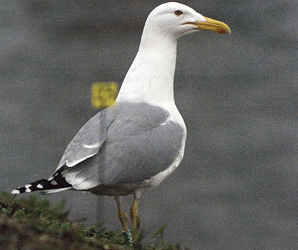 13CY Male hybrid Caspian x Herring Gull in a breeding territory, Wloclawek, central Poland, April 2008. Picture: Grzegorz Neubauer. The same bird as RIGHT & below (the red colour ring P002 was replaced in 2005). Note the typical Caspian Gull structure in this pose; in many larger-billed Caspians, as well as some slimmer-billed birds such as this hybrid, the bill, despite being deep at the base, lacks a gonys bulge and so the bill tapers continuously and markedly towards the tip. |
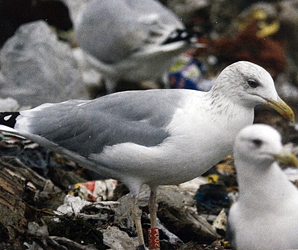 9CY Male hybrid Caspian x Herring Gull, Konin, central Poland, October 2003. Picture: Visa Rauste. Again, red P002, now photographed c. 70 km south of the breeding colony. Note the dense and rather diffuse Herring Gull-like head-streaking on this date, when the bird is in nearly complete winter plumage (the two outer primaries are not fully grown yet, so it has still to complete the moult). ln practice, such a heavily streaked individual would arouse suspicion even without the ring (and the bird’s known history). |
 |
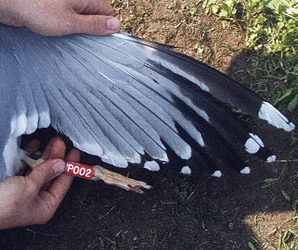 |
| 11CY male hybrid Caspian x Herring Gull, Wloclawek, central Poland, May 02 2005. Picture: Magdalena Zagalska-Neubauer. Ringed as a chick at middle Vistula, south of Warsaw, in May 1995. Like many hybrids, this bird is intermediate in appearance: note the slightly dark-spotted iris (scored as 2; see table 1) and slim bill (scored actual bill ratio computed from depth/length measurements was 3.21, thus matching Caspian perfectly; see Neubauer et al. 2007). Both of these features exclude pure Herring. Conversely, in P10 there is more black than white and the short tongue is grey, features that exclude pure Caspian. This combination of characters means that the bird would be unacceptable as a pure Caspian and also out of the range of pure Herring; if unringed, such a bird should be left as unidentified and flagged as a likely hybrid. | |
END OF PART 1
CONTINUE PART 2: HERE
 Larus cachinnans 4CY UKK L-010275 January 28 2013, Deponie Pohlsche Heide - Minden, Germany (52°23'05N, 08°46'45E).
Picture: Armin Deutsch.
Larus cachinnans 4CY UKK L-010275 January 28 2013, Deponie Pohlsche Heide - Minden, Germany (52°23'05N, 08°46'45E).
Picture: Armin Deutsch. Larus cachinnans 4CY 6P39 January 20-24 2017, Scheveningen, the Netherlands.
Larus cachinnans 4CY 6P39 January 20-24 2017, Scheveningen, the Netherlands.  Larus cachinnans 2CY & 4CY PDUS 2011 & 2013, the Netherlands. Picture: Johannes Luiten, PieterGeert Gelderblom & Maarten van Kleinwee.
Larus cachinnans 2CY & 4CY PDUS 2011 & 2013, the Netherlands. Picture: Johannes Luiten, PieterGeert Gelderblom & Maarten van Kleinwee.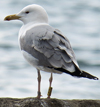 Larus cachinnans 4CY PDNP January & March 2013, Switzerland. Picture: Julien Torre & Laurent Valloton.
Larus cachinnans 4CY PDNP January & March 2013, Switzerland. Picture: Julien Torre & Laurent Valloton.  Larus cachinnans 4CY PEHV January 10 2014, Oostende, Belgium.
Picture: Roland Francois.
Larus cachinnans 4CY PEHV January 10 2014, Oostende, Belgium.
Picture: Roland Francois. Larus cachinnans PKNK September 2012, December 2014 & January 2015, the Netherlands & France.
Larus cachinnans PKNK September 2012, December 2014 & January 2015, the Netherlands & France. Larus cachinnans 2CY-4CY PHNN December 2012 - November 2014, the Netherlands.
Picture: Merijn Loeve, Jan Jacob de Vries, Albert de Jong, Dave van der Poel & Theo Muusse.
Larus cachinnans 2CY-4CY PHNN December 2012 - November 2014, the Netherlands.
Picture: Merijn Loeve, Jan Jacob de Vries, Albert de Jong, Dave van der Poel & Theo Muusse. Larus cachinnans 4CY PSHK January 18 2014, Bucharest, Romania. Picture: Gabriel Martín.
Larus cachinnans 4CY PSHK January 18 2014, Bucharest, Romania. Picture: Gabriel Martín.From Ukraine.
 Larus cachinnans 5CY 354P January 18 2012, Deponie Pohlsche Heide - Minden, Germany (52°23'05N, 08°46'45E).
Picture: Armin Deutsch.
Larus cachinnans 5CY 354P January 18 2012, Deponie Pohlsche Heide - Minden, Germany (52°23'05N, 08°46'45E).
Picture: Armin Deutsch. Larus cachinnans 4CY 10P3 January 26 2010, Deponie Pohlsche Heide - Minden, Germany (52°23'05N, 08°46'45E).
Picture: Armin Deutsch.
Larus cachinnans 4CY 10P3 January 26 2010, Deponie Pohlsche Heide - Minden, Germany (52°23'05N, 08°46'45E).
Picture: Armin Deutsch.  Larus cachinnans 1CY-3CY-4CY V455 November 2008, February 2010 & January 2011, Denmark & the Netherlands.
Larus cachinnans 1CY-3CY-4CY V455 November 2008, February 2010 & January 2011, Denmark & the Netherlands.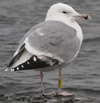 Larus cachinnans 2CY & 4CY V8X6 February - March 2008 & January 2010, Copenhagen, Denmark & Simrishamn, Sweden. Picture: Hans Larsson. & Lars Krogh.
Larus cachinnans 2CY & 4CY V8X6 February - March 2008 & January 2010, Copenhagen, Denmark & Simrishamn, Sweden. Picture: Hans Larsson. & Lars Krogh. Caspian Gull cachinnans J3NT 4CY & 8CY, January 2017 & December 2021, Scheveningen & Brouwersdam, the Netherlands. Picture: Mars Muusse &
Bastiaan van de Wetering.
Caspian Gull cachinnans J3NT 4CY & 8CY, January 2017 & December 2021, Scheveningen & Brouwersdam, the Netherlands. Picture: Mars Muusse &
Bastiaan van de Wetering.  Larus cachinnans 4cy, 11 January 2012, Boulogne-sur-Mer, NW France, Picture: Jean-Michel Sauvage.
Larus cachinnans 4cy, 11 January 2012, Boulogne-sur-Mer, NW France, Picture: Jean-Michel Sauvage. Larus cachinnans 4CY, January 05 2013, Ashdod, Israel. Picture: Amir Ben Dov.
Larus cachinnans 4CY, January 05 2013, Ashdod, Israel. Picture: Amir Ben Dov. Larus cachinnans 4CY, January 29 2010, Tineretului Park - Bucharest. Picture: Cristian Mihai.
Larus cachinnans 4CY, January 29 2010, Tineretului Park - Bucharest. Picture: Cristian Mihai. Larus cachinnans 4CY, January 29 2010, Tineretului Park - Bucharest. Picture: Cristian Mihai.
Larus cachinnans 4CY, January 29 2010, Tineretului Park - Bucharest. Picture: Cristian Mihai. Larus cachinnans 4CY, January 29 2010, Tineretului Park - Bucharest. Picture: Cristian Mihai.
Larus cachinnans 4CY, January 29 2010, Tineretului Park - Bucharest. Picture: Cristian Mihai. Larus cachinnans sub-adult, December 21 2013, Evron Dump, Israel. Picture: Amir Ben Dov.
Larus cachinnans sub-adult, December 21 2013, Evron Dump, Israel. Picture: Amir Ben Dov. 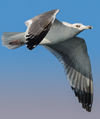 Larus cachinnans 4CY, January 03 2014, Eilat, Israel. Picture: Avi Meir.
Larus cachinnans 4CY, January 03 2014, Eilat, Israel. Picture: Avi Meir. 